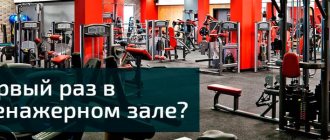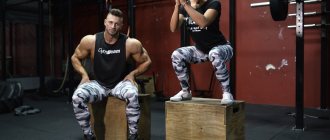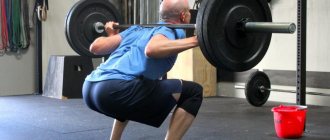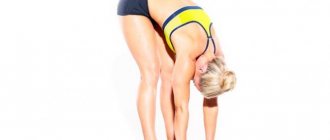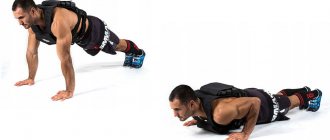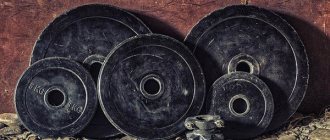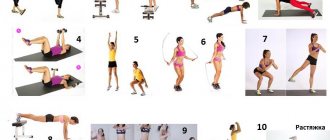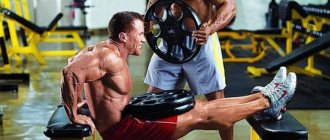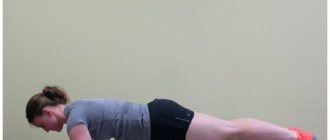If you have the right equipment and a ready-made set of exercises, you can create a fitness environment in your apartment and do strength training at home without expensive equipment.
Today, there are many online fitness programs that you can join. Another option is to create a complex yourself, based on your training goals and initial physical fitness.
This article provides principles for creating a training plan, provides strength exercises at home for men and women, and provides training sets for each gender.
Strength training at home with dumbbells or exercise machines
You can easily train and build muscles by setting up your own home gym. With basic equipment such as a barbell bench and dumbbell power rack, you can create an optimal training situation at home.
Most muscle strengthening exercises require 6-15 repetitions, no less and no more per set.
The more accurately you perform the exercises and follow these recommendations, the more effective they will be. With dumbbells or machines, split approaches work even better. You just need to put the right weight on.
Strength training at home without tools
You can also train with your own weight and thus build ripped muscles at home. But make no mistake: although this method seems accessible and natural, it is by no means the easiest way.
- Whether it's strengthening exercises at home, at the gym or in the park, your workout program should always include a continuous increase in muscle strength.
- If you only train with your own body weight, you need to change the exercise each time to make it more difficult. However, you don't have to make it overly complicated, otherwise you'll end up doing fewer reps and losing sight of your training goal.
Equipment-free strength training challenges athletes to work through their workouts down to the smallest detail and constantly gain new knowledge and movements to build muscle mass.
Fitness for men
Before you start playing sports, you need to take into account that age affects the amount of exercise. If you are over 40, then light fitness classes of up to 1 hour are better suited. They are based on basic exercises from physical education, pull-ups, abdominal work and push-ups.
Working with kettlebells, dumbbells, and barbells is welcome, but not with heavy weights. Up to 30-35 kg will be just right.
Strength fitness for men is primarily aimed at strengthening muscles and maintaining shape. The training usually begins with a short warm-up with elements of physical education, its duration is no more than 5 minutes.
Next, proceed to bench press for 2-3 approaches. Push-ups are also 2-3 sets. Squats 4 sets of 15-20 to strengthen the leg muscles. And finally, a set of exercises to work out your abs.
Equipment for training at home
Dumbbells and a fitness tracker are two pieces of equipment we recommend for strength training at home.
Minimum required equipment for training with sports equipment:
- Two dumbbells with variable weight discs and a large total weight;
- Rings or levers as a suspension system;
- Assortment of elastic bands for fitness with different resistance.
With these tools and a few items found in every home, you can create a solid workout program that you can do at home, depending on your level.
You can choose from a variety of exercises for all muscle groups, and you can progress from simple variations to more challenging ones or increase your body weight.
Duration of strength training
During sports, microdamage occurs to those muscles that are directly stressed. As a rule, the next day you will have body aches. This is a good sign of a successful workout.
The duration of power loads should be selected individually; for beginners it should not exceed 40-45 minutes.
If you don’t want to go to the gym, but train at home on your own.
An excellent solution would be to find strength fitness videos on the Internet. There, in an accessible form, you will be shown many exercises, with a correct explanation of their implementation.
The video contains strength fitness music. It is extremely important to maintain the right mindset during all exercises.
Working out the chest muscles
The simplest exercises for the pectoral muscles are as follows:
- Pushups. They start with 3-10 times, depending on their physical form, increase to 50, then they begin to use different variations: the distance between the hands, legs brought together or spread apart into a split, etc.;
- Push-ups between two chairs;
- Pull-ups on the levers of a gymnastic wall or on rings;
- Dumbbell press on the floor or on a bench;
- Pullover with dumbbells for a stool, bench, etc.
Two-day split
The different split options are usually based on us going to the gym three times a week. In a classic three-day split, muscles are divided into three groups, each group is worked out in a separate workout, just once a week, that is, in three workouts a week we will work the whole body. If we divide all the muscles of the body into two groups and work out each of the two groups in a separate workout, then we will work out the entire body in two trips to the gym. With three workouts per week, the frequency with which we subject the same muscles to stress will increase compared to a three-day split. Typically, in a two-day split, the muscles are divided according to the “top-bottom” principle or the “pull-pull” principle. “Top - bottom” means that the first workout works the muscles of the upper body, and the second - the lower body. “Pull-push” means performing various pulling movements in the first workout and pressing (pushing) movements in the second.
Program 1. “Top – Bottom”
Trainings are held on Monday, Wednesday and Friday. In the first week, you will get two workouts for the top and one for the bottom (top-bottom-top), in the second week - vice versa (bottom-top-bottom).
First training. Top
Main muscle groups of the upper body: back, chest, deltoids and arms. For each of them, at least one basic exercise must be performed. Based on this, the training is built.
- Bench press on a horizontal bench: 3×8–10;
- Incline fly (or press): 3×8–10;
- Pulldown of a vertical block to the chest: 3×8–10;
- Bent-over barbell row (or seated horizontal pull-down): 3×8–10;
- Seated barbell press, up, in the Smith Machine: 3×8–10;
- Standing biceps curl: 2×10–12;
- Vertical block triceps press down: 2×10–12.
Second training session. Bottom
- Squats with a barbell on the shoulders: 3×8–10;
- Platform leg press: 3×8–10;
- Deadlift on straight legs: 3×8–10;
- Leg bending in a special lying machine: 3×8–10;
- Standing barbell calf raises: 2×12–15.
Program 2. “Top – Bottom”
Program 1 can be changed slightly, for example, by adding deltoids or arms to the leg training, removing them from the upper training, respectively. Then the program will take on a more balanced look.
First training
- Incline Bench Press: 3×8–10;
- Dumbbell fly on a horizontal bench: 3×8–10;
- Pulldown of the upper block to the chest: 3×8–10;
- Bent-over barbell row: 3×8–10;
- Standing biceps curl: 2×10–12;
- Close grip bench press: 2×10–12.
Second training
- Squats with a barbell on the shoulders: 3×8–10;
- Platform leg press: 3×8–10;
- Bend legs in the machine: 3×8–10;
- Standing barbell calf raises: 2×12–15;
- Seated vertical chest press in the Smith Machine: 3×8–10;
- Dumbbell swings from side to side while standing: 3×10–12;
- Standing bent over dumbbell swings: 3×10–12.
Program 3. “Pull - Push”
First training. "Pull"
- Row of barbell (lower block) to the stomach: 3×8–10;
- Pulldown of the upper block to the chest: 3×8–10;
- Deadlift on straight legs: 3×8–10;
- Bend the legs in the machine while lying down: 3×8–10;
- Standing biceps curl: 3×8–10.
- Second training session. "Push"
- Squats with a barbell on the shoulders: 3×8–10;
- Platform leg press: 3×8–10;
- Bench press: 3×8–10;
- Dumbbell incline press: 3×8–10;
- Smith machine seated chest press: 3×8–10;
- Vertical block triceps presses: 2×10–12.
A similar scheme, but based primarily on basic movements and with limited volume, was proposed in the early 90s by Stuart McRobert in the book “Think. Bodybuilding without steroids."
Program 4. “Abridged”
Day 1
- Barbell squats: 3×10–15;
- Bench press: 3×8–12;
- Barbell curl: 3×8–12;
- Close grip bench press: 3×8–12.
Day 2
- Deadlift: 3×10–15;
- Pull-up on the bar: 3×8–12;
- Seated dumbbell press: 3×8–10;
- Calf raise: 3×15–20;
- Curl: 3×15–20.
The program execution scheme for a week might look like this:
The next week starts from day No. 2, that is, day 1 and day 2 change places, and the rest days are the same.
Upper back
Here it is recommended to use:
- Pull-ups on outdoor horizontal bars: beginners with a fitness band, professionals with additional weight;
- Scrolling the arms (angle depending on the level);
- Door pull: grasping the doorway, bending with tense muscles back/forward;
- Bent-over dumbbell row:
- The latissimus muscles are pumped with straight arms;
- Alternating or simultaneous flyes and shrugs with dumbbells or a fitness band.
Shoulder load:
- Lateral raise with dumbbells or fitness bands;
- Shoulder press with dumbbells;
- Reverse dumbbell swing;
- Front raise with dumbbells or fitness bands.
As endurance and strength develop, fitness bands and dumbbells must be changed to heavier and more springy ones.
Limb training at home
Suitable for hand relief:
- All variations of dumbbell curls;
- Stretching the arms with a fitness tape of varying springiness;
- Working with rings;
- Pull-up bar;
- Pull-ups on levers or rings;
Legs and buttocks:
- Air squats: while hanging on the horizontal bar, press your legs as close to your body as possible;
- Squats with dumbbells in spread arms or with one in front of you;
- Lunges (with dumbbells);
- Split squats;
- Pelvic lift (with dumbbells);
- Leg extension on the ground with band;
- Burpee;
- Romanian deadlift with dumbbells.
The choice is great, but it is not always possible to find an exercise that will work every muscle in three approaches. The legs and buttocks are particularly muscular by nature and can withstand heavy loads from the very beginning.
This problem can be circumvented using so-called "intensive methods". They make it difficult to perform exercises even without using heavier loads.
Isometric muscle tension between sets
It should be emphasized again that intensive methods are not the best option for increasing productivity. If you have the opportunity, you should first increase the load during your training or perform a slightly more difficult exercise with your own weight, and only then increase the time for each exercise and the number of repetitions.
This will have a more positive effect on muscle development than training your muscles too lightly.
Important:
- Repeat several exercises for the same muscle (before or after you feel muscle fatigue).
- Increase the number of approaches;
- Reduce breaks between sets;
- Train each set to muscle failure;
- Maintain the final position of the movement for several seconds;
- Perform repetitions very slowly (about 10 seconds per repetition);
- Performing slow movements in the opposite direction;
- Dividing the exercise into partial movements.
In other words, it is necessary to work on the intensity to the limit of what is possible, and only when the usual number of exercises for all muscle groups becomes easy to do, increase their number or repeat the complex more often.
Top 100 Best Exercises for Home Workout
Top 100 exercises for home workout Many people live only with work/study, and they have no time left for other interests. What to do if you want to both work and play sports? Just for such cases, below are the most productive exercises for home training that will work every muscle in your body and strengthen them (abdominal muscles, arms, buttocks, back, etc.). Home workouts are the best option, because not everyone has the time, and also the finances, to pay for a monthly subscription to a gym or fitness club. Some people simply don’t want to waste time getting to the gym and back. These not-so-complicated home exercises will help you get moving and gradually get in shape. Most people don't have sports equipment at home, but that's okay. You can perform exercises with body weight and achieve success.
- It is important to know that when doing exercises, nothing and no one should interfere with you.
- If you are doing the exercises and feel any discomfort, most likely you are doing the exercise incorrectly. Technique is very important in sports
- You need to focus not on how to do it faster, but on whether you are doing it right. There are a lot of videos on the Internet about how to do the exercises correctly; they will help you at first. By delving into the correct execution of exercises, you will greatly benefit from the work done.
- The technique also implies that you need to maintain proper breathing. The videos or descriptions underneath also tell you how to breathe better
- If you can't do certain exercises, don't get discouraged. It just takes time for your body to get used to it. Every time you perform an exercise that doesn’t work out, body parameters (for example, flexibility) will develop and the result will not be long in coming.
It happens that you can easily perform exercises with your body weight, you feel stronger and can do much more. Then you can apply weights. Not having a kettlebell or dumbbells at home is not a problem. Life hack: you can put water in a 5-liter bottle (or two 1-liter bottles). This will be a good alternative to dumbbells. Or you can put books in a bag/package, which will also serve as a replacement for weights. There are a lot of interesting and effective exercises for home. Choose more convenient exercises for yourself. You can experiment with increasing the weight (if you want), with rest intervals (rest more to restore strength, or rest less to build endurance), and the intensity of the exercises performed.
- Training should not be done every day. It takes 24 hours for your body to fully rest, so you can do it every other day.
Exercises for home training are suitable for everyone, so don’t be lazy, go towards your goal. Important! If you feel severe pain in your body, you should not engage in sports activities. Remember that your goal is to benefit, not harm, your body!
